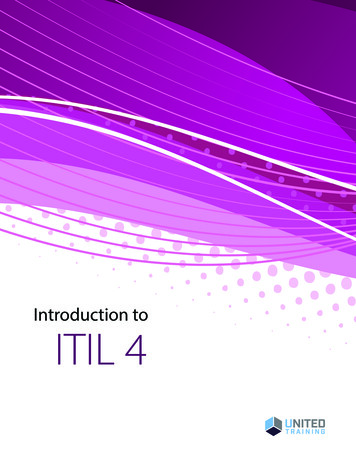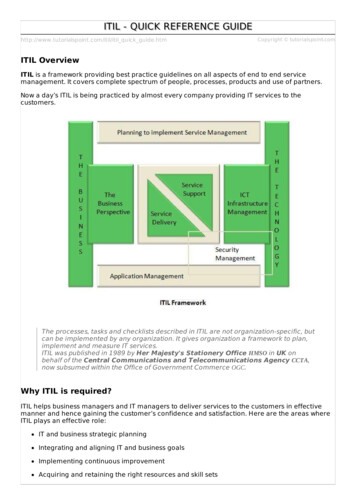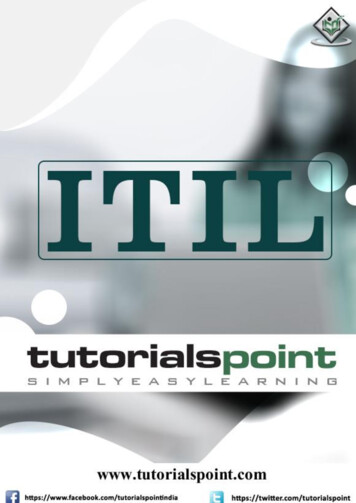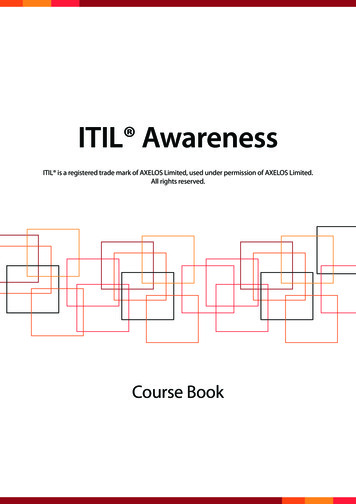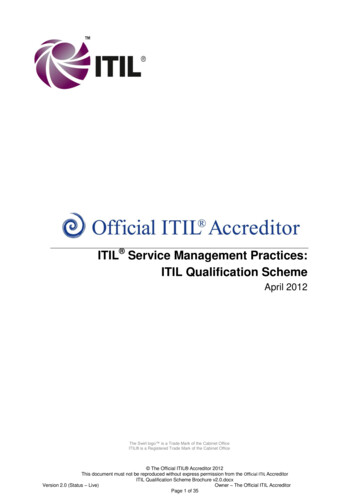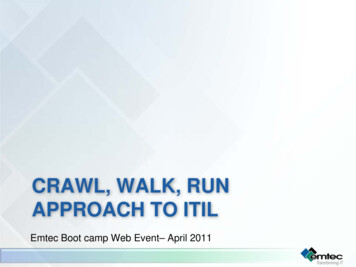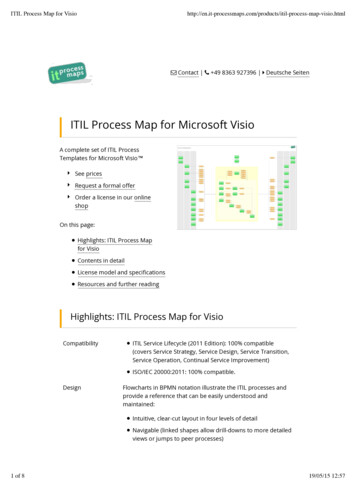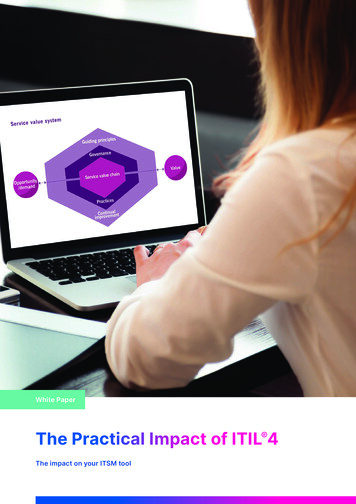
Transcription
White PaperThe Practical Impact of ITIL 4The impact on your ITSM tool
ContentIntro3The high-level impact of ITIL 4 on ITSM tools4The focus on value and new reporting and analytics requirements4Non-IT ITSM tool usage4The call for increased automation5The impact on ITSM tool structures6The potential impact of individual ITIL 4 practices7Commonly adopted processes/practices8Less-commonly adopted processes/practices9New processes/practices11Future ITSM tool development12The authors13
IntroMuch has been talked and written about ITIL 4. However, most of this has been aboutthe new terms such as the “service value chain” and the “ITIL 4 management practices.”For organizations that use the previous ITIL v3/2011 version, this is helpful but still mightleave them unclear as to the practical help ITIL 4 offers in light of their ongoing need toimprove business performance and outcomes by increasing their IT service management(ITSM) maturity.This white paper series helps shed some light on this. The first white paper explained thenew ITIL 4 concepts briefly. It focused on how organizations can benefit from ITIL 4 andexplained the impact on people. The second white paper focused on the practical impactof the changed and new ITIL 4 practices. Now, this third white paper covers the impactof ITIL 4 on ITSM tools. It outlines the tool features needed to support the adoption ofnew and changed ITIL 4 practices, by ITSM tool customers such as yourself, plus howlikely it is that the ITSM tool vendors without these capabilities will invest in their futuredevelopment.White Paper The Practical Impact of ITIL 43
The high-level impact ofITIL 4 on ITSM toolsHow ITIL 4 impacts ITSM tools is multi-layered and not just relatedto the changed management practices. Some of these layers are discussed below.The focus on value andnew reporting and analyticsrequirementsNon-IT ITSM tool usageThe ITIL 4 concept of value co-creation and the useperspective.ITIL 4 is aimed at service management per se rather than just ITSM, with this impacting the needsof ITSM tools from an enterprise service managementof value streams affect the design and capabilities ofITSM tools.The adoption of enterprise service management –“the use of ITSM principles and capabilities in otherWhile the use of value steams – rather than ITIL v3/2011business areas to improve performance, service,processes – can be catered for through the use of theand outcomes” – has grown significantly in the lastgraphical workflow engines found in most successfulfive years. And while ITIL 4 doesn’t explicitly talkITSM tools, there’s also the need to move from volume-to enterprise service management, its serviceand activity-based metrics – such as “how many” and management approach will no doubt make ITIL“how long” – to those that better articulate the positive guidance highly applicable to enterprise servicebusiness outcomes, and the value that’s co-created,management strategies (and back-office digitalto key business stakeholders.transformation initiatives).An example of this is minimizing vehicle productionThe improved non-IT accessibility of ITIL 4 will alsodelays and losses caused by IT issues for a carpotentially help to drive the use of ITSM tools outside manufacturer. Or, for a healthcare provider, increasingof IT, which will require ITSM tools to offer the followingthe number of patients through digitalized processes.enterprise service management capabilities if theyThis requirement to refocus metrics, with appropriatedon’t already:tool enablement of performance measurement andreporting, is likely also true for your organization’s Great, consumer-like, user (employee) experienceneed to measure and improve employee experience. Data access controls and separation betweendifferent business function domains Easy integration with corporate systems (not justIT systems) The ability to introduce new data objects that arenot related to IT (e.g. facilities assets) Task and process automation (and increasinglyAI-enabled capabilities) Flexibility to match the ways of working acrossbusiness functions Multidimensional knowledge managementWhite Paper The Practical Impact of ITIL 44
The call for increased automationNew technologies, and now ITIL 4’s push for morehere. With the new technology – along with traditionalautomation, are already impacting customer expecta-automation capabilities – helping to fulfill the ITIL 4tions of ITSM tool capabilities. Artificial intelligence (AI),guiding principle of “optimize and automate.” Thisor more specifically machine learning, plays a big partincludes AI-enabled ITSM capabilities such as:Fig. 1: AI-enabled ITSM capabilitiesChatbots and virtual agentsWith the latter being where the AI, based on machine learning, augments staff knowledgeand capabilities.Intelligent automation for ticket handlingThe automated categorization, prioritization, assignment, and potentially processingof incidents and requests.AI-assisted knowledge managementFrom intelligent search, through intelligent email autoresponders, to the identificationof knowledge gaps and automated article creation.AI-assisted decision support and trend identificationFrom problem management to demand planning and staffing optimization.AIOpsMachine-learning-based event management that identifies what’s important amongstall the event management “noise” and, where appropriate, acts.These capabilities might be provided in a variety ofor by an unrelated third-party provider. Importantly,ways. For example, within the ITSM tool itself (includingmany of these AI-enabled capabilities are alsoembedded third-party technology/solutions), via an applicable in enterprise service managementintegration with a tool-vendor technology partner, scenarios.White Paper The Practical Impact of ITIL 45
The impact on ITSM tool structuresNotwithstanding the changes called out in section 1So far, there’s no industry-agreed view on this, eitherof this paper, the loss of the ITIL v3/2011 ITIL Lifecyclefrom AXELOS or ITSM tool vendors. With it inevitablein ITIL 4 also has a significant impact on ITSM toolthat ITSM tools will continue to present their ITSMstructures, i.e. how the various tool capabilities arecapabilities in line with the ITIL v3/2011 structure forshown to the user. ITIL v3/2011 has been used as athe foreseeable future – until a new solution is agreed“blueprint” for ITSM tool design for over a decade, withupon (based upon which of the new and changedall of the service operation capabilities grouped, all themanagement practices are sufficiently adopted byservice transition capabilities grouped, and so on. Nowcustomers). For example, whether organizationalthat service strategy, service design, service transition,change management capabilities are repeatedly calledservice operation, and continual service improvementfor by customers, such that it becomes a standardare no longer the convenient “homes” for the ITILITSM tool feature set, will ultimately influence howprocesses/practices, it means that a new logicalany ITIL-4-based tool structure is created.structuring is needed.White Paper The Practical Impact of ITIL 46
The potential impact ofindividual ITIL 4 practicesWhile the previous section covers the tool-wide impact of the new and changed managementpractices, each practice in itself might require specific ITSM tool features.Fig. 2: The 34 ITIL 4 management practicesGeneral managementpracticesArchitecture management Continual improvement(ITIL v3/2011: continual serviceimprovement)Information security managementKnowledge managementMeasurement and reportingOrganizational change management Portfolio management(Service portfolio management)Project management Relationship management(ITIL v3/2011: business relationshipmanagement)Risk management Service financial management(ITIL v3/2011: financial managementfor IT services) Strategy management(ITIL v3/2011: strategy managementfor IT services)Supplier management Workforce and talent managementService managementpracticesAvailability managementBusiness analysis Capacity and performancemanagement(ITIL v3/2011: capacity management) Change enablement(ITIL v3/2011: change management)Technical managementpractices Deployment management(ITIL v3/2011: release anddeployment management) Infrastructure and platformmanagement Software development andmanagementIncident management IT asset management(service asset and configurationmanagement) Monitoring and event management(ITIL v3/2011: event management)Problem management Release management(ITIL v3/2011: release anddeployment management)Service catalog management Service configuration management(ITIL v3/2011: service asset and configuration management) Service continuity management(IT service continuity management) Service design(ITIL v3/2011: design coordination) Service desk(was an ITIL v3/2011 function)newname change or split Service level managementunchanged naming Service request management unchanged naming(ITIL v3/2011: request fulfilment)but content changes Service validation and testingWhite Paper The Practical Impact of ITIL 47
Commonly adopted processes/practicesThe ITSM tool features that support the most commonly adopted ITIL processes/practices willbe needed by the majority of the IT organizations that want to transition their ITSM operations,and the practices they employ, from ITIL v3/2011. The Required ITSM Tool Features list belowassumes that you – the ITSM tool customer – wishes to bring your existing ITSM capabilities inline with the new ITIL 4 guidance.ITIL 4 practiceRequired ITSM tool featuresChange enablementThis practice requires DevOps-related capabilities. From integrations to DevOps toolchainsto the addition of related capabilities (including increased change automation and orchestration), perhaps even DevOps modules. These features will also likely be requested by IT organizations that do not plan to adopt ITIL 4.ContinualAny capabilities requested for this practice are less related to the evolution of continual improvementimprovement itself and more to the greater emphasis on improvement in ITIL 4. However,ITSM tools have, for over a decade, previously ignored the addition of improvement-relatedcapabilities – likely based on lack of customer demand – so if it’s not already in your ITSMtool it’s unlikely that this will change in light of other “more wanted” ITIL-4-related additions.DeploymentAs with change enablement, any ITSM tool features required are likely related to DevOps managementmethods and the increased use of automation in terms of continuous integration, continuousdelivery, and continuous deployment.Incident managementThe obvious demand for new ITSM tool capabilities for incident management wouldbe support for swarming such that incident handling can be collaboration based.Problem managementThe greater use of automation and machine learning for proactive incident prevention islikely to be the most wanted and beneficial new feature request. ITIL 4 also reintroducederror control and problem control after they were dropped in ITIL v3/2011. If they wereever removed from the more mature ITSM tools they could now return.Release managementAs with change enablement and deployment management, release management capabilitiesneed both greater alignment with DevOps methods (and tools) and the increased use ofrelease automation. For example, in enabling the use of blue/green releases and featureflag approaches.Service catalogITSM tools need to be able to cater to the use of service offerings and not just individualmanagementservices. This is the bundling of service components to make service catalog entries business-focused rather than service-provider-focused.Service configurationAn important tool feature is the integration with third-party tools such as Vagrant, Ansible,managementPuppet, and Docker that allow organizations to take an “infrastructure as code” approach.This is where the IT infrastructure reflects the configuration management database (CMDB)rather than the traditional view of the CMDB reflecting the infrastructure – and where changescreated within the CMDB are automatically enacted within the infrastructure.White Paper The Practical Impact of ITIL 48
ITIL 4 practiceRequired ITSM tool featuresService deskThere are two potential needs for ITSM tools related to the new ITIL 4 service desk practice.One is the use of “query” record/status to reflect something that’s presented by an end userbefore it’s categorized – it could eventually be an incident, a request, or something else. Theother need is for omnichannel support – and this need is not only being driven by the adoptionof ITIL 4 guidance, but it’s also a larger market shift. Some ITSM tools will need to add toadditional channels and capabilities – for instance, chat and chatbots – to meet this need.Either natively or via technology partners.Service levelExperience management capabilities and the use of eXperience level agreements (XLAs) are managementan ITSM tool feature request that’s being driven by the market and not just ITIL 4. This is likelyto have a high customer demand as interest and adoption grows.Service requestThe ITIL 4 guidance adds in what was commonly already being provided bymanagementmany ITSM tools – service request catalogs, workflow automation, and serviceorchestration. It’s inclusion in ITIL 4, however, does make it table stakes forthose ITSM tools that don’t already provide these capabilities going forward.For completeness, the following commonly adopted ITIL 4 practices are thought unlikely to elicit any specificfeature requests for ITSM tools: Knowledge management Monitoring and event managementLess-commonly adopted processes/practicesTool features which support less-commonly adopted ITIL processes/practices will not berequested by the majority of IT organizations, even though there are opportunities to addvalue to ITSM operations and outcomes. The following list of potential new ITSM tool featuresis therefore likely to be omitted from ITSM tool vendor product development plans.ITIL 4 practicePotential new ITSM tool featuresInformation securityThe new tool features required by this practice are likely to be more from an enterprise servicemanagementmanagement than ITSM perspective. For example, automated workflows for security incidenthandling that are aimed at security rather than ITSM roles.Portfolio managementThe replacement of the two-dimensional ITIL v3/2011 service portfolio management approachwith something that’s more akin to traditional (project) portfolio management means thatthere’s potentially the need for PPM-based capabilities that can prioritize investments acrossservices, projects, and other improvements. If these features are not already part of your ITSMtool, then it’s likely that they will be delivered by technology partners.White Paper The Practical Impact of ITIL 49
ITIL 4 practicePotential new ITSM tool featuresRelationshipThe wider view of relationship management within ITIL 4 requires ITSM tools to add management capabilities that support collaboration and interaction-based documentation. Some ITSM toolsalready provide these features. However, for the customers of those that don’t, the likelihoodis that relationships will continue to be managed within personal emails and spreadsheetsrather than using the capabilities of ITSM tools to best advantage. For example, the useof weighted matrices to measure the health of relationships and linkages to continualimprovement to improve in areas that are causing relationship issues.Service continuityPost-COVID, this is likely to be an area at the top of IT service provider agendas. This practice,managementunlike the others in this list, will likely impose feature requests. Although probably from anenterprise service management rather than an ITSM perspective. For example, the use ofautomated workflows to help manage the creation, review, regular testing, and improvementof service (and wider business) continuity plans.Service financialOn the one hand, the post-COVID impact on budgets should necessitate that IT servicemanagementproviders show better financial stewardship. On the other, the 2008 financial crisis offeredthe same hope that what was then called IT financial management would see greateradoption. Today only the bigger, mature IT organizations tend to have ITFM or service financialmanagement in place. The key difference now though is in the cloud arena which, althoughnot called out in ITIL 4, will necessitate that IT organizations seek cloud cost management/optimization capabilities – for infrastructure and software license costs and multi/hybrid cloudenvironments. For this ITSM tools need to integrate with at least the most common cloudservice providers.Supplier managementThe key requirement for ITSM tools for this practice is the introduction of support formulti-supplier sourcing arrangements – commonly referred to as service integration andmanagement (SIAM). For example, the ability for incident tickets to easily move betweenthe customer organization and multiple suppliers and the support for service level targetsthat reflect more complex service delivery arrangements across multiple parties.For completeness, the following less-commonly adopted ITIL 4 practices are thought unlikelyto elicit any specific feature requests for ITSM tools: Availability management Capacity and performance management Service design Service validation and testing Strategy managementWhite Paper The Practical Impact of ITIL 410
New processes/practicesAs new ITIL 4 processes/practices, only time will tell how they’ll be individually adoptedby organizations and the ITSM tool changes that will both follow and drive adoption.ITIL 4 practicePotential new ITSM tool featuresOrganizationalThis is, in many ways, very similar to the requirements for continual (service) improvementchange managementthat have perennially been overlooked within ITSM tools. This is the provision of work andworkflow capabilities related to organizational change management that guide people throughthe required steps, leveraging pre-built templates, guidance, tools, and workflows that help toensure that what needs to be done is done. With the ability to plan, collaborate, manage risksand issues, see and report progress, document decisions, capture learnings, and othercapabilities that are needed for effective organizational change management.IT asset managementFor some ITSM tools, these capabilities are already present and will likely remain unchanged(ITAM)despite the ITIL 4 addition. Other ITSM tool vendors might consider strategic acquisitions ofITAM tool vendors – for both their tool capabilities and existing customer base – rather thanundertake the necessary and mammoth task of creating ITAM capabilities from scratch.The alternative is to continue with ITAM-related technology partnerships. The decision willultimately depend on customer demand for ITAM capabilities as the industry does or doesn’tadopt the newly added ITIL 4 practices.Project managementEven more so than with ITAM, this will depend on whether customers expect their ITSM toolto offer project management capabilities in light of ITIL 4. Again, some ITSM tools alreadyoffer these but it’s unlikely that they will be seen as important as ITAM, say, when ITIL 4adoption is factored into organizations’ ITSM tool requirements. Especially when third-partytools can easily be employed and integrated.Risk managementThe new overarching approach to risk management in ITIL 4 requires risk-related capabilitieswithin other practices (which may or may not be supported by the ITSM tool). These includechange enablement, information security management, portfolio management, problemmanagement, project management, and service continuity management. For example, viarisk registers and risk assessment forms and matrices.Workforce and talentWhile this new practice includes a wide range of people management capabilities suchmanagementas resource planning, recruitment, onboarding, performance management, learning anddevelopment, and succession planning, much of this will likely continue to be managed withinand enabled by the corporate human resources (HR) tool(s). Other than the potential additionof IT skills management matrices, the likely impact on ITSM tools is again likely to be from anenterprise service management rather than an ITSM perspective.For completeness, the following new ITIL 4 practices are thought unlikely to elicit any changesin ITSM tools: Architecture management Business analysis Infrastructure and platform management Measurement and reporting Software development and managementWhite Paper The Practical Impact of ITIL 411
Future ITSM tool developmentAs already stated, some of the ITSM tool requirements needed for your organization’s adoption of the new and changed ITIL 4 practices may alreadybe supported by your current ITSM tool. If not, a key point to appreciate is thatthe ITSM tool vendors missing these capabilities will plan their developmentroadmap based on aggregate customer wants and needs – in terms of bothpleasing existing customers and winning new business.Given the wide range of potential ITIL-4-based changes to ITSM tools, most vendors will sensiblyfocus their investments on the needs of these customers – prioritizing what these customersare actually asking for over what could be changed or added relative to ITIL 4. So, for example,additional AI-based capabilities might be added to ITSM tools ahead of continual improvementcapabilities.Fig. 3: How ITIL 4 features will be added to ITSM toolsPractice-specificSome ITSM tools already offer changes in ITIL 4ITIL-4-included capabilities.Customers requestMost customer requests will relateITIL 4 changes plusto the ITIL practices they already use. other changes such as AIThe successful use of new ITIL 4features will drive more featurerequests.ITSM tool vendors addITIL 4 features might be low prioritythe most popular ITIL 4compared to other industry-wide needsrequests for change tosuch as AI-enabled capabilities.their roadmapsNew ITIL 4 capabilitiesare added to ITSM toolsGiven this approach, any ITIL-4-based changes to ITSM tools will take time. With it in many wayssubject to the “chicken and the egg” metaphor where customers can’t see how they can benefitfrom the addition of new capabilities until they can see and use those capabilities.White Paper The Practical Impact of ITIL 412
The authorsStephen Mann is Principal Analyst and Content Director at ITSM.tools,an independent, ITSM-focused analyst firm. He is a frequent blogger,writer, and presenter on the challenges and opportunities for IT servicemanagement professionals.Martin Landis works for USU as an expert in IT and enterprise servicemanagement. He has over 15 years of experience in developing andsuccessfully deploying tools to manage services within IT as well as inother service areas such as human resources, facility management andfield service.Get in touch forfurther information.USU-202011www.usu.comSmart Businesses use USUinfo@usu.com · www.usu.com
Problem management Release management (ITIL v3/2011: release and deployment management) Service catalog management Service configuration management . Release management As with change enablement and deployment management, release management capabilities need both greater alignment with DevOps methods (and tools) and the increased use of




